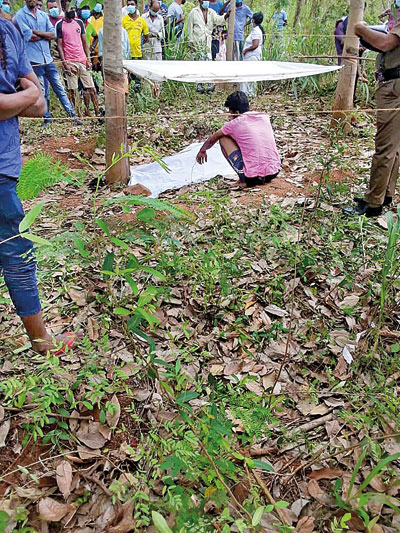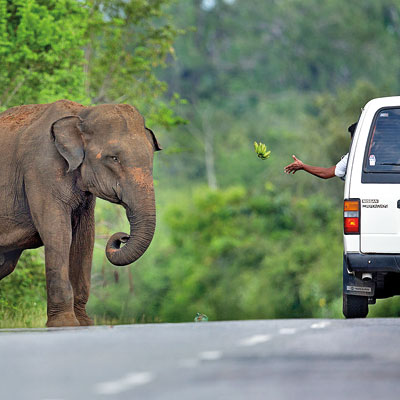News
Ditch electric fences – human-elephant deaths are rising

The two farmers thought they were safe after chasing off a herd of elephants coming into their paddy fields. It was frightening work – elephants have killed more than 15 people around their homes in Kahatagasdigiliya, Anuradhapura in recent months.
The other villagers who had been with them went home but these two farmers, both in their sixties, stayed behind to watch over their crops, thinking they were safe.
But danger struck: one of the elephants had remained hidden and, encouraged by the absence of a frightening crowd of humans, attacked the two isolated men and killed them.
The attack, last weekend, came a day after another person was killed by an elephant while out at night taking care of his cattle. The man’s body was found the following day by a fellow villager.
As human-elephant conflict takes an escalating toll on life on both sides, a government body this week threw its weight behind a proposal tirelessly advocated by noted elephant expert Dr. Prithviraj Fernando to minimise damage and deaths.
This week, the Committee on Public Accounts (COPA) said government policy, mainly resting on the erection of electric fences around national parks and jungle villages, had to change because human and elephant deaths have kept rising while more and more fences are put up.
COPA states in its report, presented to parliament, that the policy of constructing electric fences that trap elephants in discrete areas of forest that hold limited food and water is a failure because it is mainly innocent female elephants and baby elephants that are trapped: evidence shows that large male elephants, which forage apart from a herd, are responsible for most harm caused to humans and crops.

An electric fence in Padiyathalawa Muragala: Pic by Wasantha Chandrapala
Presenting the report, Professor Tissa Vitharana said that although the government had allocated large sums of money from the annual Budget to mitigate the human-elephant conflict the problem remained unchanged and now Sri Lanka had the highest number of elephant deaths in the world due to this conflict.
COPA revealed that although the average number of elephant deaths caused by humans averaged 272 over past years, 407 elephants had been killed in 2019. That year the number of human deaths caused by elephant attacks also jumped, from an annual average of 85 to 122 deaths.
The committee stressed the need for immediate action on this issue, recommending that the 2020 “Action Plan for the Mitigation of Human-Elephant Conflict” replace current Department of Wildlife Conservation (DWC) policy. The action plan came from a committee, chaired by Dr. Fernando, that was set up by President Gotabaya Rajapaksa to come up with proposals to prevent human-elephant conflict.
Dr. Fernando backs the setting up of seasonal electric fences around village cultivation areas that are taken down after harvest-time when there is nothing to attract the elephants.
He emphasises that the erection of electric fences around forest reserves should be curtailed as they trap elephants in small areas of limited food and water resources. He said electric fences should instead be kept for protecting human habitat.
The report noted that trials of a programme conducted by Dr. Fernando in Galigamuwa show it has been successful in avoiding conflict, with costs kept to a minimum. The programme emphasised that villagers be educated about elephant behaviour, such as roaming patterns, so that they can protect themselves better.
Dr. Fernando said that 80 per cent of the human fatalities from conflict with elephants could be prevented through a better understanding of elephant needs and behaviour. COPA has endorsed that approach in its report.
Dr. Fernando has long urged for more funding to be committed to a programme for putting radio collars on elephants to track their roaming habits and better understand how to adapt to them.
Prof. Vitharana urged the wildlife department to prepare an action plan and gain the co-operation of the Mahaweli Authority and the Forest Department to obtain land for the construction of elephant reserves.
The COPA committee further emphasised the importance of harnessing the army, navy, air force, Civil Defence Department, agrarian organisations and villagers in constructing and maintaining fences and trenches in the way suggested by Dr. Fernando.

Gonadanara: Victim of an elephant attack. Pic by Nayanajeewa Bandara
Commending COPA’s report, the Director of the Environmental Conservation Trust, Sajeewa Chamikara, backed a change in policy saying electric fences were a “minor solution” for a lasting problem and more sustainable solutions needed to be the first resort.
In the past seven months, 167 elephants and 58 humans have died as a result of human-elephant conflict resulting from the steady reduction in forest areas due to large-scale development projects and land cleared by farmers. The resulting destruction of the animals’ food and water sources are the main reasons for their invasions into farmland and villages in search of sustenance.
COPA said in the dry zone alone there were 58 garbage dumping sites that attracted elephants close to human habitation.
Reservoirs in the Mahaweli Authority areas, the foremost elephant habitats, faced destruction, it warned.
The report asks for 8,500 acres of land to be set aside for elephant habitat in Kandakadu, near Welikanda in the Polonnaruwa area, and says that protected forest areas that have been fragmented by human encroachment should be joined into a network.
A spokesman from the Ministry of Environment and Wildlife Resources, Wasantha Chandrapala, said a new type of electric fence had been successful in minimising conflict.
“We are planning to reinforce the electric fences programme,” he said.
“We designed an electric fence that allows people and livestock to pass freely but stops the elephant. The fence has four electrified wires with electrified braces and ‘whiskers’ placing the poles out of reach of trunks. This is powered by solar power and the frequency prevents the elephants coming near.”
These electric fences are 15 feet high compared to normal fences with a height of six feet, and have the wires strung vertically, emitting sound at a frequency that unsettles elephants and keeps them away from the structure so that they do not electrocute themselves by trying to crash through the wire.
The fences have already been set up in Anapallawa in Wellawaya and Mahagodayaya in Buttala.
The government expects to use unemployed youth recruited under the Multipurpose Development Taskforce to erect the fences and maintain them under the guidance of the wildlife department.
Committees are to be established in each village to drive away elephants from villages until wildlife officials arrive and deal with the problem. The committees will collect and provide information about the movement of the animals.
“We will ensure the long-term survival of elephants in the wild by establishing their habitats as well as by introducing elephant corridors,” Mr. Chandrapala said.
He said five new range wildlife offices are to be built in the Anuradhapura district, Medawachchiya, Mihintale, Horowpothana-Kebithigollewa and Kahatagasdigiliya.
“At the moment, seven problem elephants have been identified,” he added. The wildlife department plans to keep them in holding grounds to prevent them from creating further problems to humans. Funds had been approved to establish holding grounds in Lunugamwehera.
“The first and foremost thing is educating people that coexistence with elephants is the remedy to human-elephant conflict,” Mr. Chandrapala said.
 Motorists warned against feeding elephants roaming near Buttala-Kataragama main roadWild elephants along the Buttala-Kataragama main road have become a major attraction for those travelling along this route. Motorists warned against feeding elephants roaming near Buttala-Kataragama main roadWild elephants along the Buttala-Kataragama main road have become a major attraction for those travelling along this route. Some people even stop to feed them. The elephants, used to being fed, usually come close to the main roads in search of food. This has become a threat to both the elephants and people. The road leads to Buttala from Kataragama, through Block 5 of the Yala National Park, and recently it was observed that wild elephants have been coming to the main road quite frequently to get food from people travelling on this route. Now, the number of elephants roaming around this area has increased. The food they are fed with could cause problems for them, and this behaviour also increases the risk of motor traffic accidents as vehicles usually travel fast on these remote roads, wildlife enthusiasts have warned. Some elephants even become aggressive and charge at vehicles. The relevant authorities have put up sign boards beside these roads, explaining the threat and advising people to refrain from feeding the elephants. Pic by Kasun Liyadipita | |

